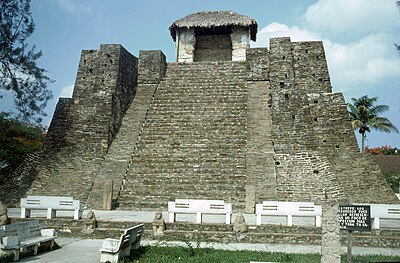Castle of Teayo
| Castillo de Teayo | |
|---|---|
| Archaeological site | |

Archaeological site
|
Castillo de Teayo is a mesoamerican Prehispanic archeological site and Mesoamerican pyramid, located in the La Huasteca region in northern Veracruz, Mexico. The main access to the site is via Federal Highway 130 México-Tuxpan up to the city of Teayo, it belongs to the Huastec culture and it is estimated it was inhabited between the 10th and 12th centuries.
In the modern era the contemporary settlement of Castillo de Teayo developed around the ancient pyramid that the settlement and its municipality of Castillo de Teayo were named after. In the Tuxpan Canvas, this place is represented by the Teayotlán glyph. According to one version, the name etymology comes from the Huastec language word teayo o teayoc, which means “on the stone turtle”.
Another official version of the name is that it comes from the Nahuatl word Teayok, Te-ayo-k “Turtle on stone”. The site received its current name because there is a temple or archaeological monument in the municipality, as the only remaining vestige of a large ancient city, a mixture of the Olmec and Huastec cultures. It used to be called Tzapotlán.
This site was home of one of the ancient Huastec cities. Its occupation periods are calculated from the 10th to the 12th centuries, and during the Late Postclassic period it developed a strong Mexica influence. In the center of the town is a pyramidal shaped building that preserves part of its entire structure, with a stairway and a structure that crowned the building, probably a temple, and it is one of the few buildings of this type remaining in the mesoamerican area. In the small site museum are kept sculptures found in the surrounding area, whose stylistic features depict phallic worship, very common in some cultural regions. More information is available in the small site museum which contains sculptures found during excavations of the city. Some of the sculptures were found in the area, characterized a cult-like phallic style, very popular in some ancient cultures.
...
Wikipedia
